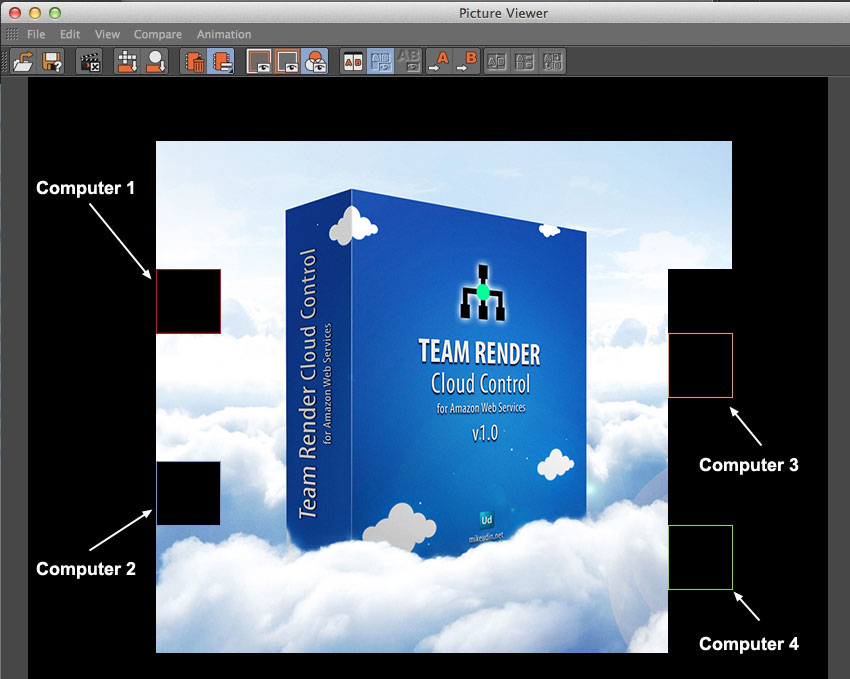Personal Team Render farm in the Amazon EC2 cloud!
Frequently Asked Questions
-
With Team Render, you can quickly and easily render on multiple computers (on which the same version of CINEMA 4D must be installed) across a local network with the click of a button. These computers can not only be used to render animations but can also be combined to render a single image:If Team Render is used to render an animation, each client computer will render one entire frame of animation at a time. On the 16 version Cinema 4D offers a server-based system for Team Render, with a browser-based user interface for managing and monitoring jobs:
-
Amazon Web Services — is a collection of remote computing services, also called web services, that make up a cloud-computing platform offered by Amazon.com. These services operate from 11 geographical regions across the world. The most central and well-known of these services arguably include Amazon Elastic Compute Cloud, also known as "EC2", and Amazon Simple Storage Service, also known as "S3". Amazon markets AWS as a service to provide large computing capacity more quickly and more cheaply than a client company building an actual physical server farm.
-
There are services like Amazon Web Services. Microsoft Azure, Google Cloud Platform and others. Each of them has its own specifics, but in general the cloud from Amazon is now in many ways ahead of them in a variety of characteristics.
-
Oddly enough, the most difficult may be registering a new AWS account, because the system verifies users sometimes serious and some require proof of address and other information. An important and critical part is to configure correct image (AMI), installing and configuring software, it needs to be done once. The rest does not require much effort.
-
This is the computer all the hardware that emulates special software and does not physically exist. That is, one physical computer can create multiple virtual operating independently computers. For example, to run a windows-application or old game console under the MacOs, you can use special software emulators.
Amazon EC2 virtual machines creates the operating system Linux and Windows Server. In the AWS terminology they are called instance. Several instances are combined in a high-speed virtual LAN, which allows them to run based on Cinema 4D Team Render.
-
Render farms provide very high power and really helps to reduce rendering time even for very complex scenes. But usually, they are limited to a specific set of programs and plug-ins. Also do not make it possible to save money, when there is no need for high-speed rendering, but you need to optimize costs.
-
By using Amazon EC2 you pay for hourly virtual machines and storage space, which stores virtual machine images, as well as for the outgoing Internet traffic that passes the result rendering. Calculate your costs, you can use a special calculator on this page.
-
The more virtual machines, the powerful Team Render farm is created on their basis. The maximum number of virtual machines that can run at the same time depends on many factors: the type of instance, the request type, and others. This is an average of 20 instances at a time. If you need more, you need to make a request on a special page. There is a limit for new accounts, which is removed after a month of using AWS. For more information about the limit on the number of virtual machines AWS EC2 you can read here.
-
Безусловно cобрать виртуальную Team Render ферму можно и самому. Of course to create a virtual Team Render farm and you can own. In this video tutorial I detail how to do it. But if you plan to periodically use the cloud rendering c AWS EC2, I recommend utility TRCC, it will save your money and time.
-
This can be done using the AWS Cloud Watch. This is a service that monitors the EC2 instances and the other AWS resources. Cloud Watch can track when running instance reduces the load on the CPU, which says that, for example, Cinema 4D rendering stopped and then send you an alert and/or stop/terminate the instance.
-
It's simple. Start from an existing AMI instance, make the necessary changes to the system, and then in the EC2 console choose command "Save Image" to save the state of this instance as a new image with a different name. I recommend not to delete old images as long as based on them will not be the new tested for performance.
Ask us a question or leave a comment:
